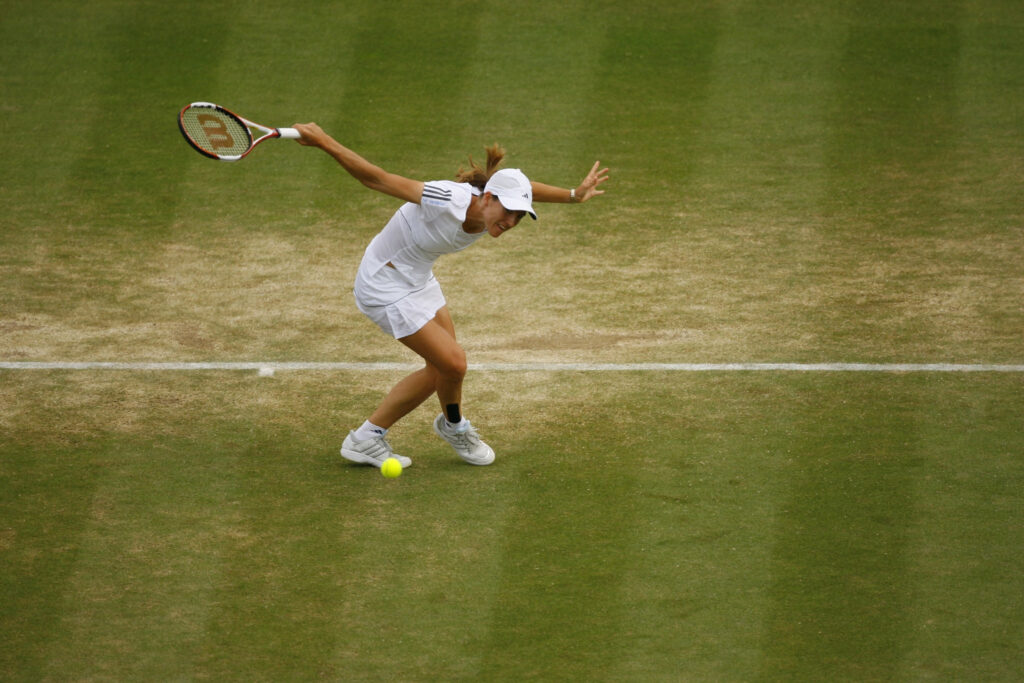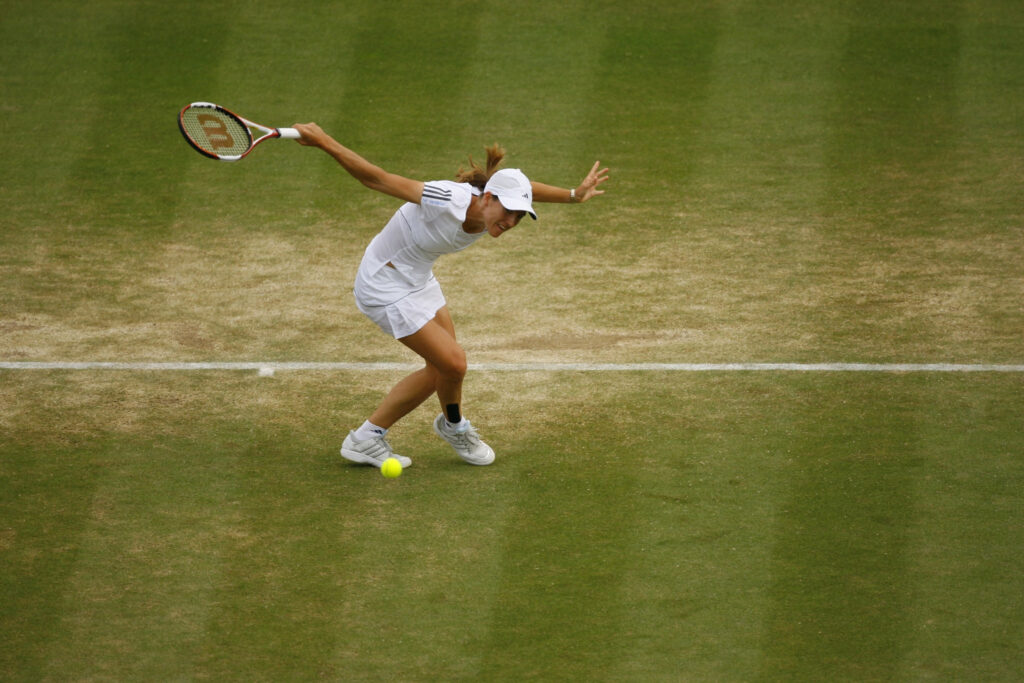Justine Henin could have been a worthy foil for Serena Williams, if only she had kept playing
By Alex Macpherson
For over a decade, men’s tennis was defined by one of the greatest rivalries of all time. Roger Federer and Rafael Nadal ushered in a golden age for the ATP; entire books have been devoted to individual matches in the 35-strong “Fedal” series, which wrote a late and unexpected chapter in 2017 Australian Open final. But in the same time period, tennis fans were robbed of a rivalry that had the potential to define the WTA in similar ways. Serena Williams and Justine Henin were polar opposites in temperament, in style, and in their very approach to tennis both as a sport and as entertainment; their battles captured the imagination like few other matchups this century. But while Federer vs. Nadal was a fire that reignited men’s tennis, Serena vs. Justine burned brightly but flickered out too soon.
Since Henin’s first retirement in 2008, Serena has underlined her status as the Greatest of All Time in women’s tennis— putting the accolade beyond all doubt with her 23rd Slam title in Australia, an Open Era record. In that time, she has seemed to exist separately from the rest of the sport. Her dominance over the field—sometimes exerted with an iron fist, sometimes casually toyed with as her interest has waxed and waned—has been such that it’s strange to even consider Serena having rivals in any meaningful sense of the word. The best the field have salvaged are crumbs from a monarch’s table: a couple of hard-fought wins over her to mitigate double-digit losses; a Slam title here and there. As Serena approached, struggled with, and overcame milestones in her tally of titles—first the target of 18 to bring her level with Chris Evert and Martina Navratilova, then Steffi Graf’s former Open Era record of 22—it’s been evident that Serena’s greatest rivalry of the 2010’s was with history.

But it wasn’t always such. Serena, as much as any sporting legend, has been molded by her greatest matchups. There are several candidates for her ultimate foil. Martina Hingis was a fellow teenage prodigy, but it always felt like she was more Venus’ rival than Serena’s: The younger Williams took three years from her US Open victory over Hingis as a 17-year-old to really start fulfilling her potential for dominance. The year she kicked off her first of two Serena Slams, 2002, was just a year before Hingis’ first of two retirements (to date) as the Swiss prodigy limped off tour at the age of just 22, beset by chronic injuries; the pair would never play again after Serena handed her a final emphatic thrashing in Miami of that year to edge ahead in the head- to-head, 7–6, for good.
In any case, surprisingly few of the Serena/ Hingis showdowns were classic matches—a notable exception being the pulsating Australian Open quarterfinal in 2001, in which Hingis eked out an 8–6 third set, one of only four deciders the pair completed. More formative were Serena’s battles against Jennifer Capriati and her sister, Venus. The sturdy, pugnacious Capriati set the template for one of the few game styles to reliably trouble Serena over the course of her career: You can still see echoes of her turbo-grinding approach in the best matches Victoria Azarenka has played against Serena in recent years. And if Capriati constituted a physical hurdle to overcome, Venus was an emotional one: Learning to overcome her younger-sibling complex and usurp her elder sister’s position was surely a mental test that fortified Serena’s legendary mental strength.
But both the Capriati and Venus rivalries ultimately followed a similar arc: Rather than a pendulum swinging back and forth between equal competitors, they were reversals as the superior player figured a tough opponent out, then dominated them. Serena lost four of her first five showdowns with Capriati— and then turned it around to win eight straight, and ultimately eight of their final 11 meetings. She ceded four of her first five pro matches against Venus to the senior Williams—and then won 17, of the next 24. There was a point at which both matchups became predictable. This was never the case for Serena’s most compelling rival, the Belgian Justine Henin. It was the perfect rivalry on paper: The contrast between the two women was a beautiful encapsulation of the diversity the sport can hold. Serena, charismatic and glamorous, was as irrepressible a force off the court as on it, embracing the worlds of fashion and celebrity with the same fervor as she sent aces booming down and backhands skidding past her helpless opponents. Transcending the sport has never been a side effect of Serena’s athletic greatness, but a goal from the start.
Justine, meanwhile, was a brooding introvert who rejected the idea of celebrity beyond tennis before it even came calling. Throughout her career, she probably wore as many different outfits as Serena would showcase in a month, and they were minor variations on basically the same ascetic design. While Serena took to the court in catsuits, denim skirts, and Cameroonian football socks that commanded you to look at her, Justine pulled her baseball cap low over her face and sought to deflect your eyes away from her person as anything other than a vehicle for her tennis. Look at me; don’t look at me: the twin impulses of public figures embodied in two iconic players.

Their tennis, too, wasn’t just a stylistic contrast but pitted two fundamental philosophies on how the game should be played against each other. Justine was a figurehead for old-school artistry: She would rhapsodize about expressing herself on court in interviews as though she was a singer, and indeed the delicacy of her finesse—and that gorgeous one-handed backhand—could ha ve a lyrical beauty to it. Serena, on the other hand, was laser-focused on winning with the utmost efficiency, on circumventing the poetry of long rallies with the full stop of power. Tennis fans tend to be instinctively drawn to one style or the other, and can often be found gazing blankly and uncomprehendingly across the aisle at the opposite side.
Then there was the personal edge— and, in this case, the personal was political in some subtle ways. Their rivalry boiled over in the 2003 Roland Garros semifinal in a tempestuous final set that saw Serena dissolve beneath the boos of the French crowd and her opponent’s failure to acknowledge her raised hand to signal her unreadiness to receive. The backdrop was the start of the Iraq War, and Serena’s mockery of the French pacifist stance a few months previously—but it was also Serena’s position as a black woman in a traditionally white sport, in one of its most traditional venues, playing an opponent with a traditional game, and being vociferously rejected. Serena and Justine were seen, at this point, as the quintessential products of their continents, emblematic of qualities beyond mere tennis. But—one of the indications that they were more alike than they seemed—it was also telling that both were marginalized rather than embraced at home. Serena has been called many things over the years, but never the appellation “America’s sweetheart”—something the media have been quick to attach to her whiter compatriots, from Capriati to Melanie Oudin. Meanwhile, Belgium’s golden girl during its tennis boom wasn’t Justine but the less accomplished Kim Clijsters, privileged daughter of a football star and permanently perky popularity-poll winner. In both scenarios, toxic attitudes about race and class intertwine with ideas about the personalities deemed acceptable in female athletes: Serena’s overt emotionality has long offended audiences disproportionately, but Justine’s refusal to play the marketing game and give up more of herself was also seen as dour, even sour.
Perhaps the saddest aspect of this great rivalry, though, was that it never really happened. Justine’s coming-of-age as a Slam champion in 2003 should have set it alight; instead, with both women taking it in turns to be racked by injury and illness, they didn’t play between Wimbledon 2003 and Miami 2007, years that should have constituted their athletic primes. Five meetings over the following 12 months would give fans hope of a rekindling, only for Justine to abruptly retire in May 2008. They contested just one Slam final, the 2010 Australian Open, barely a month into a Justine comeback that seemed over as soon as it had begun.
Serena and Justine should have been the WTA’s Roger and Rafa: All the ingredients of a rivalry for the ages were there. But the story of women’s tennis in the mid-’00s was one of frustration interspersed with flashes of hope. Federer and Nadal spent the decade playing week in, week out: The Fedal files are a formidable, 35-match body of work of data to be analyzed and glorious tennis to be rhapsodized. It’s tempting to feel bitter about the meager 14 contests that comprise Serena vs. Justine and what might have been. But it’s ultimately telling that, even with this scant amount, a rivalry that never was still captured the imagination in so many ways.


